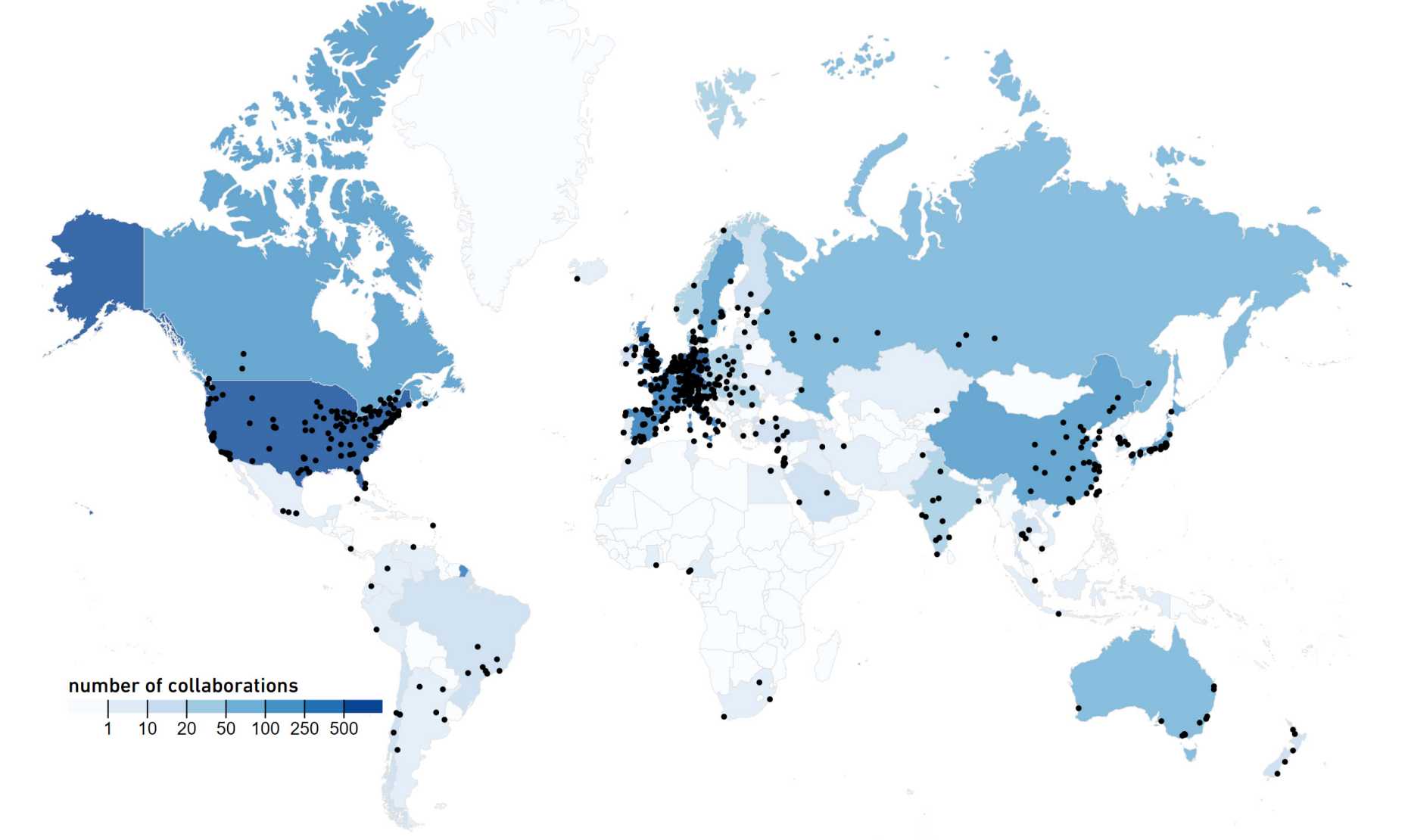Better together: mapping D-CHAB’s collaborations
- D-CHAB
- LAC
- LPC
- LOC
- IPW
- Highlights
- ICB
Science is a team effort, also at the D-CHAB at ETH Zurich. Since 2009, there have been anually more than 1800 collaborations with partners from around 48 countries, as illustrated by the new interactive map on the D-CHAB website. But what do collaborations mean for research and research success? A look at what holds the research world together.
A challenging year is over, and the Corona crisis has again made it clear: Some scientific issues are too big to tackle alone. They require expertise that only a collective can provide in a certain time frame. This is addressed, for instance, with the recently introduced Higher Education Cooperation Index of the European Commission, exclusive to their U-Multirank system. Six years long, data were analyzed for aspects such as strategic partnerships, international co-publications, co-publications with industry partners and co-patents. The analysis showed, that working together is a particularly good strategy in many areas.
Regarding the ranking, Swiss higher education institutions, among the top ones ETH Zurich, perform very strongly in U-Multirank’s categories Research, Knowledge Transfer and International Orientation. This also fits with the study results published in Nature in 2017 by Wagner and Jonkers. Their data showed that Switzerland appears as the most connected country when international papers are considered in relation to the country's total publication output. Overall, according to the study authors, countries like Switzerland benefit from international collaborations primarily because of their openness and high-impact research, which translates into high citation rates.

Fruitful synergies in the D-CHAB
That collaboration is an advantage and highly valued is also reflected in the D-CHAB. As the new interactive map on the D-CHAB homepage shows, researchers here have maintained more than 1800 collaborations with partners from around 48 countries over the past thirteen years (according to the data retrieved from Scopus). There have been particularly many collaborations within Switzerland and with neighboring countries such as Germany, France and Italy, but also with more distant countries such as the USA and China.
"Collaborations allow us to address scientific problems with technologies and methods, that complement those of the own group. They allow different insights and help to broaden our scientific horizons," emphasize Prof. Cornelia Halin Winter (IPW) and Prof. Sereina Riniker (LPC), who are with this opinion in good company at D-CHAB. Patrick Steinegger, a professor at the LAC, also appreciates the exchange with other groups. In radiochemistry, he relies on global partnerships: "Global networking and access to large research facilities at partner institutions allow us to accelerate research in an efficient way, which ultimately allows society to benefit more quickly from knowledge gathered, for instance, in fundamental research."
The acceleration also results from the fact that problems can be solved faster together. This way, the group of Prof. Christophe Copéret (LAC) has already "been able to tackle problems, for instance, in NMR, EPR and X-ray absorption spectroscopy", while Prof. Gunnar Jeschke’s Group (LPC) could demonstrate through a collaboration, that their methodology for measuring nanometer-range distances distributions in proteins can be applied to systems that are currently of great interest in structural biology. For Prof. Andrea Burdon’s group and Prof. Klaus Eyer’s group, on the other hand, collaborations help to "transform developed methods into the most beneficial systems for patients and society" and "bridge the gap between basic and clinical research."

Collaborations have already yielded fruitful synergies in the LOC as well. Prof. Erick Carreira, for example, recalls one project in particular: After having found efficient synthetic strategies for the preparation of cannabinoids, he and his group forged a team comprising academic and industry partners to develop and profile CB2-specific fluorescent probes. "A metric that captures the notable achievements of this global collaborative effort is the published manuscript in J. Am. Chem. Soc. which included 57 co-authors from nine different countries spread across three continents," Prof. Carreira explains, "however, an even more significant measures of success are the countless ideas and innovations which have since arisen as a consequence of fruitful discussions, which continue to inspire research in our group. Through collaborative endeavors synthetic chemists have the unique opportunity to expand their experience and competence as scientists by actively contributing to the process of discovery."
In that sense, collaborations are, as Prof. Robert Grass (ICB) puts it, "the best and most efficient way to link knowledge from other fields with our own research, and to learn from other fields, in both technical and research cultural terms." It may be challenging, and hard work at times to reconcile such different cultures and ambitions, but success vindicates those who dare. In the end, it’s better to do research together, especially in the face of future challenges, whether Corona- or climate-related.
About the interactive map
The motivation behind the interactive map and our collaboration website was to highlight how important collaborations are for research. The map is based on affiliation data from Scopus (Elsevier) and shows the institutions of the co-authors of D-CHAB professors and the number of joint publications. On the corresponding website you will also find a collection of statements of D-CHAB professors explaining in personal terms the role collaborations play in cutting-edge research and how they influence output.
Further Information
Wagner and Jonkers: Open countries have strong science. Nature 550, 32–33 (2017). external page doi.org/10.1038/550032a